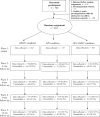HIV risk reduction among detained adolescents: a randomized, controlled trial
- PMID: 19901006
- PMCID: PMC9017687
- DOI: 10.1542/peds.2009-0679
HIV risk reduction among detained adolescents: a randomized, controlled trial
Abstract
Objectives: Criminally involved adolescents engage in high levels of alcohol-related risky sex. A theory-based sexual and alcohol risk-reduction intervention was designed, implemented, and evaluated in juvenile detention facilities.
Participants and methods: In a randomized, controlled trial, 484 detained adolescents received 1 of 3 group-based interventions: combined sexual and alcohol risk reduction (group psychosocial intervention [GPI] + group motivational enhancement therapy [GMET]); sexual risk reduction only (GPI); or HIV/sexually transmitted disease prevention information only (group information-only intervention [GINFO]). Follow-up data were obtained 3, 6, 9, and 12 months after the intervention. Behavioral outcomes were condom-use behavior, frequency of intercourse while drinking, and alcohol-related problems.
Results: Condom-use behavior measured as frequency of condom use during sex (ranging from never to always) decreased over time, although the GPI and GPI + GMET interventions mitigated this tendency at the 3-, 6-, and 9-month follow-up assessments. Although both active interventions were significantly more successful than the GINFO condition and the pattern of effects favored the GPI + GMET, there were no statistically significant differences between the GPI and GPI + GMET interventions.
Conclusions: Findings support the feasibility of integrating alcohol-specific sexual risk content into a theory-based sexual risk-reduction intervention and provide additional evidence that theory-based interventions are effective at reducing risky sex in this population. There was limited evidence of intervention effects on alcohol-use outcomes. Future research should focus on strengthening the GPI + GMET to most effectively target risky sexual behavior among at-risk adolescents.
Trial registration: ClinicalTrials.gov NCT00914719.
Figures




References
-
- Centers for Disease Control and Prevention. Young People at Risk: HIV/AIDS Among America’s Youth. Atlanta, GA: Centers for Disease Control and Prevention; 2002.
-
- Whaley AL. Preventing the high-risk sexual behavior of adolescents: focus on HIV/AIDS transmission, unintended pregnancy, or both? J Adolesc Health. 1999;24(6):376–382. - PubMed
-
- Barthlow DJ, Horan PF, DiClemente RJ, Lanier MM. Correlates of condom use among incarcerated adolescents in a rural state. Crim Just Behav. 1995;22(3):295–306.
Publication types
MeSH terms
Associated data
Grants and funding
LinkOut - more resources
Full Text Sources
Medical

